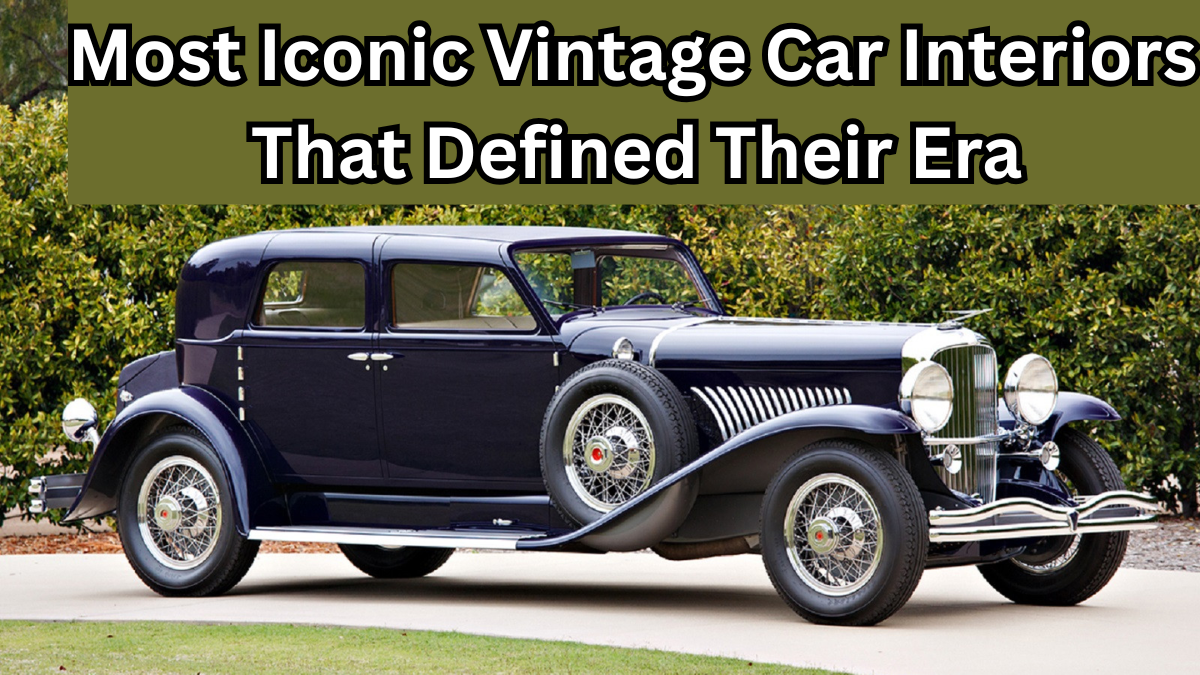There’s something undeniably special about stepping into a vintage car. The scent of aged leather, the gleam of polished wood trims, and the intricate craftsmanship of the controls and dials instantly transport you to another time. While modern vehicles boast digital everything, the vintage car interiors of the past were all about personality, detail, and craftsmanship.
Let’s take a nostalgic journey through some of the most iconic car interiors from the past, highlighting the artistry behind those classic dashboard designs and the materials that shaped generations of automotive luxury.

Why Vintage Car Interiors Still Matter?
Even in today’s world of touchscreen infotainment systems and minimalist cabin layouts, the interiors of vintage cars continue to inspire designers and car enthusiasts alike. Here’s why:
-
Timeless craftsmanship: Handmade elements and materials like walnut wood, leather, and chrome
-
Unique styling: Each brand had a distinctive interior design language
-
Driver-centric dashboards: Instruments that weren’t just functional, but a visual delight
-
Cultural icons: Interiors that echoed the fashion, architecture, and spirit of their era
Top Vintage Car Interiors That Defined Automotive History
Here’s a curated list of some of the most iconic vintage car interiors that left an indelible mark in automobile design.
1. 1957 Chevrolet Bel Air
-
Two-tone vinyl bench seats
-
Striking jet-age inspired classic dashboard design
-
Full-width speedometer with stylish chrome accents
-
Matching door panels and patterned carpets
2. 1961 Jaguar E-Type
-
Sleek toggle switches and brushed aluminum trim
-
Leather bucket seats with sporty stitching
-
Minimalist yet elegant vintage car interior
-
Clear, driver-focused dials for performance lovers
3. 1955 Mercedes-Benz 300SL Gullwing
-
Quilted leather seats and chrome-trimmed knobs
-
Art deco style instrument cluster
-
Unique butterfly-style steering wheel
-
Luxury meets innovation in every inch
4. 1964 Ford Mustang
-
Dual-cockpit layout with symmetrical dashboard
-
Wood-rimmed steering wheel for added class
-
Optional Rally-Pac gauges for a sporty feel
-
Affordable American muscle wrapped in style
5. 1970 Citroën SM
-
Futuristic single-spoke steering wheel
-
Space-age toggle switches and dial arrangement
-
Bright upholstery colors that pop
-
A bold mix of comfort and avant-garde design
Comparison Table: Iconic Features by Car
| Car Model | Signature Interior Feature | Material Focus | Era it Defined |
|---|---|---|---|
| 1957 Chevrolet Bel Air | Jet-age dashboard + full-width speedo | Chrome & Vinyl | Rock n’ Roll ‘50s |
| 1961 Jaguar E-Type | Toggle switches + sporty seats | Leather & Aluminum | Swinging Sixties |
| 1955 Mercedes-Benz 300SL | Gullwing doors + art deco dials | Quilted Leather & Chrome | Post-war Elegance |
| 1964 Ford Mustang | Dual-cockpit dash + wood steering | Faux Wood & Vinyl | Muscle Car Revolution |
| 1970 Citroën SM | Single-spoke wheel + bold styling | Fabric & Plastic | Futuristic ‘70s |
Elements That Made These Interiors Iconic
To truly understand what makes these interiors unforgettable, let’s look at the elements that tied them all together:
Materials and Craftsmanship
-
Premium leathers and real wood finishes
-
Hand-stitched seats and dashboards
-
Solid, tactile switches and knobs
Bold, Thematic Design Choices
-
Space-age and jet-inspired styling in the ‘50s
-
Sporty and functional layouts in the ‘60s
-
Experimental shapes and colors in the ‘70s
Function Meets Fashion
-
Everything had a purpose but was designed to impress
-
Dashboards were more than just control panels—they were focal points of the entire interior
FAQs
1. What makes a vintage car interior iconic?
A truly iconic interior blends functionality, high-quality materials, and a design that reflects the cultural and aesthetic values of its time.
2. Are classic dashboard designs still influential today?
Absolutely. Many modern luxury cars pay homage to classic dashboard designs by incorporating retro toggle switches, wood paneling, and analog gauges.
3. Can you restore a vintage car interior to its original condition?
Yes. Many restoration experts specialize in sourcing authentic materials and replicating factory-original stitching and layouts.
4. What’s the difference between a vintage and classic car interior?
“Vintage” typically refers to older pre-World War II cars, while “classic” includes vehicles from the 1950s through the 1980s. However, both terms are often used interchangeably when describing historic or collectible interiors.
Final Thoughts
The interiors of the past weren’t just about transportation—they were expressions of identity, innovation, and artistry. These most iconic car interiors from the past remind us that beauty and design truly matter, even behind the wheel. Whether you’re a collector, a designer, or just someone who appreciates the charm of vintage car interiors, there’s a lot to admire (and be inspired by) in these rolling time capsules.
Click here to learn more
